oil change PONTIAC GRAND-AM 1995 Owners Manual
[x] Cancel search | Manufacturer: PONTIAC, Model Year: 1995, Model line: GRAND-AM, Model: PONTIAC GRAND-AM 1995Pages: 354, PDF Size: 17.81 MB
Page 225 of 354
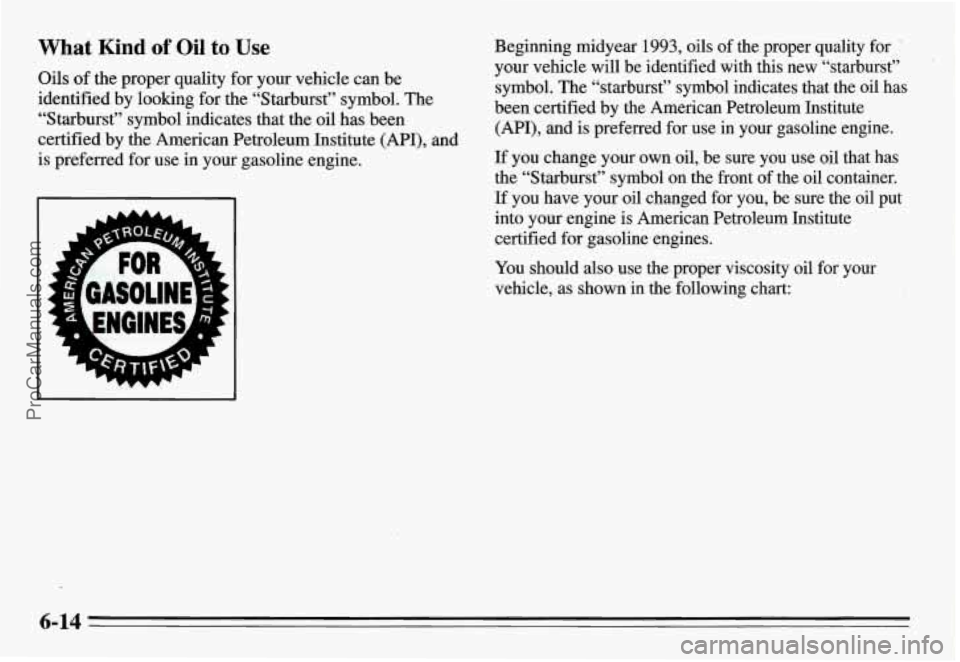
What Kind of Oil to Use
Oils of the proper quality for your vehicle can be
identified by looking for the “Starburst” symbol. The
“Starburst” symbol indicates that the oil has been
certified by the American Petroleum Institute
(API), and
is preferred for use in your gasoline engine.
Beginning midyear 1993, oils of the proper quality for
your vehicle will be identified with this
new “starburst”
symbol. The “starburst” symbol indicates that the oil has
been certified by the American Petroleum Institute
(MI), and is preferred for use in your gasoline engine.
If you change your own oil, be sure you use oil that has
the “Starburst” symbol on the front of the oil container.
If you have your oil changed for you, be sure the oil put
into your engine is American Petroleum Institute
certified for gasoline engines.
You should also use the proper viscosity oil for your
vehicle,
as shown in the following chart:
6-14
ProCarManuals.com
Page 227 of 354

When to Change Engine Oil
See if any one of these is true for you:
Most trips are less than 5 to 10 miles (8 to 16 km).
This is particularly important when outside
temperatures are below freezing.
Most trips include extensive idling (such as frequent
driving in stop and go traffic).
0 Most trips are through dusty areas.
0 You frequently tow a trailer or use a carrier on top of
your car.
If any one of these is true for your vehicle, then you
need to change your oil and filter every
3,000 miles
(5 000 km) or 3 months -- whichever comes first.
If none of them is true, change the oil and filter every
7,500 miles (12 500 km) or 12 months -- whichever
comes first.
Engine Coolant Heater
An engine coolant heater can be a big help if you have
to park outside in very cold weather,
0 OF (- 18 O C) or
colder.
If your vehicle has this option, see “Engine
Coolant Heater” in the Index.
What to Do with Used Oil
Did you know that used engine oil contains certain
elements that may be unhealthy for your skin and could
even cause cancer? Don’t let used oil stay on your skin
for
very long. Clean your skin and nails with soap and
water, or a good hand cleaner. Wash or properly throw
away clothing or rags containing used engine oil. (See
the manufacturer’s warnings about the use and disposal
of oil products.)
Used oil can be a real threat to the environment. If you
change your own oil, be sure to drain all free-flowing oil
from the filter before disposal. Don’t ever dispose of oil
by putting it in the trash, pouring it on the ground, into
sewers, or into streams or bodies of water. Instead,
recycle it by taking it
to a place that collects used oil. If
you have a problem properly disposing
of your used oil,
ask your dealer, a service station or a local recycling
center for help.
6-16
ProCarManuals.com
Page 229 of 354

Air Filter Replacement
1. Remove the screws on the housing cover and pull the
cover back.
2. Remove the air cleaner filter.
3. Install the replacement air cleaner filter and replace
the cover.
4. Tighten screws on the air filter cover.
Automatic Transaxle Fluid
When to Check and Change
A good time to check your automatic transaxle fluid
level is when the engine oil
is changed. Refer to the
Maintenance Schedule to determine when to change
your fluid. See “Scheduled Maintenance Services” in the
Index.
How to Check
Because this operation can be a little difficult, you may
choose to have this done at your Pontiac dealer Service
Department.
If you do it yourself, be sure to follow all the instructions
here, or you could get
a false reading on the dipstick.
Too much or too little fluid can damage your
transaxle.
Too much can mean that some of the
fluid could come out and fall on hot engine parts
or exhaust system parts, starting a fire. Be sure to
get an accurate reading if
you check your
transaxle fluid.
Wait at least 30 minutes before checking the transaxle
fluid level if you have been driving:
0 When outside temperatures are above 90°F (32” C).
0 At high speed for quite a while.
0 In heavy traffic -- especially in hot weather.
While pulling a trailer.
6-18
ProCarManuals.com
Page 231 of 354
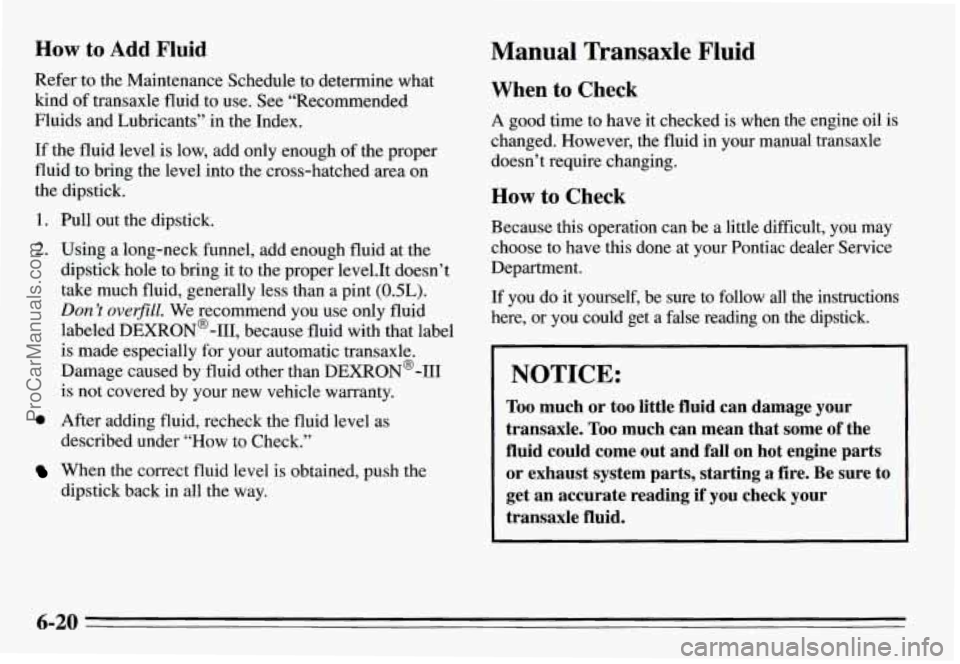
How to Add Fluid Manual Transaxle Fluid
Refer to the Maintenance Schedule to determine what
kind of transaxle fluid to use. See “Recommended
Fluids and Lubricants” in the Index.
If the fluid level is low, add only enough of the proper
fluid to bring the level into
the cross-hatched area on
the dipstick.
1. Pull out the dipstick.
2. Using a long-neck funnel, add enough fluid at the
dipstick hole to bring it to the proper 1evel.It doesn’t
take much fluid, generally less than a pint (OSL).
Dun ’t overjill. We recommend you use only fluid
labeled DEXRON@-111, because fluid with that label
is made especially for your automatic transaxle.
Damage caused by fluid other than DEXRON@-III
is not covered by your new vehicle warranty.
0 After adding fluid, recheck the fluid level as
When the correct fluid level is obtained, push the
described under “How to Check.”
dipstick back in all the way.
When to Check
A good time to have it checked is when the engine oil is
changed. However, the fluid in your manual transaxle
doesn’t require changing.
How to Check
Because this operation can be a little difficult, you may
choose to have this done at your Pontiac dealer Service
Department.
If you do it yourself, be sure to follow all the instructions
here, or you could get a false reading on the dipstick.
r NOTICE:
Too much or too little fluid can damage your
transaxle.
Too much can mean that some of the
fluid could come out and fall on hot engine parts
or exhaust system parts, starting
a fire. Be sure to
get an accurate reading if you check your
transaxle fluid.
6-20
ProCarManuals.com
Page 270 of 354
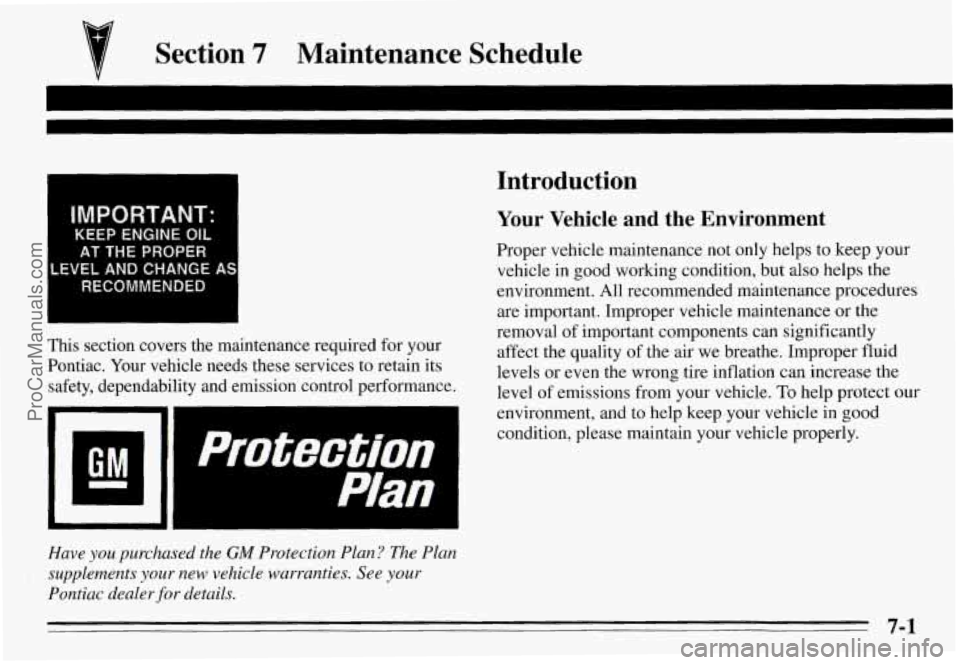
Section 7 Maintenance Schedule
IMPORTANT:
KEEP ENGINE OIL
AT THE PROPER
LEVEL AND CHANGE AS
RECOMMENDED
This section covers the maintenance required for your
Pontiac. Your vehicle needs these services to retain its
safety, dependability and emission control performance. ~~
1
Protection I
Have you purchased the GM Protection Plan? The Plan
supplements
your new vehicle warranties. See your
Pontiac dealer for details.
Introduction
Your Vehicle and the Environment
Proper vehicle maintenance not only helps to keep your
vehicle in good working condition, but also helps the
environment. All recommended maintenance procedures
are important. Improper vehicle maintenance or the
removal
of important components can significantly
affect the quality of the air we breathe. Improper fluid
levels or even the wrong tire inflation can increase the
level of emissions from your vehicle.
To help protect our
environment, and to help keep your vehicle
in good
condition, please maintain your vehicle properly.
7-1
ProCarManuals.com
Page 273 of 354

Maintenance Schedule
Schedule I Definition
Follow Maintenance Schedule I if any one of these is
true
for your vehicle:
Most trips are less than 5 to 10 miles (8 to 16 km).
This is particularly important when outside
temperatures are below freezing.
Most trips include extensive idling (such as frequent
driving in stop and go traffic).
Most trips are through dusty areas.
0 You frequently tow a trailer or use a carrier on top of
your car. (With some models, you should never tow a
trailer. See “Towing a Trailer” in the Index.)
S’chedule
I should also be followed if the vehicle is used for
delivery service, police,
taxi, or other commercial application.
Schedule I Intervals
Every 3,000 Miles (5 000 km) or 3 Months,
Whichever Occurs First
Every
6,000 Miles (10 000 km) or 6 months,
Whichever Occurs First
Chassis Lubrication
Engine Oil and Filter Change
Schedule I Intervals
At 6,000 Miles (10 000 km) - Then Every
12,000 Miles
(25 000 km)
Every 15,000 Miles (25
000 km)
Tire Rotation
Air Cleaner Filter Inspection, if driving in dusty
conditions
Every 30,000 Miles (50 000 km)
Air Cleaner Filter Replacement Spark Plug Replacement (except 2.3L Code
D
Spark Plug Wire Inspection (except 2.3L Code D
Fuel Tank, Cap and Lines Inspection
Engine Accessory Drive Belt Inspection (or every 24 months, whichever occurs first)
Cooling System Service (or every 24 months, whichever occurs first)
Every 50,000 Miles (83 000 km)
Every
100,000 Miles (166 000 km)
engine) engine)
Automatic Transaxle Service (severe conditions only)
Spark Plug Replacement (2.3L Code
D engine only)
7-4
ProCarManuals.com
Page 274 of 354

Maintenance Schedule
Schedule I1 Definition I
Follow Schedule I1 ordy if none of the conditions from
Schedule
T is true.
I Schedule I1 Intervals I
Every 7,500 Miles (12 500 km)
whichever occurs first)
occurs first)
Engine Oil and Filter Change (or every 12 months,
Chassis Lubrication (or every
12 months, whichever
At 7,500 Miles (12 500 km) - Then Every
15,000 Miles
(25 000 km)
Tire Rotation
Every 30,000 Miles (50 000 km)
Engine Accessory Drive Belt Inspection (or every
Cooling System Service (or every
24 months,
Spark Plug Replacement (except
2.3L Code D
Spark Plug Wire Inspection (except 2.3L Code D
Air Cleaner Filter Replacement
Fuel Tank, Cap and Lines Inspection
24 months, whichever occurs first)
whichever occurs first)
engine)
engine)
Every 50,000 Miles (83 000 km)
Automatic Transaxle Service (severe conditions only)
Every 100,000 Miles (166 000 km)
Spark Plug Replacement (2.3L Code D engine only)
7-5
ProCarManuals.com
Page 275 of 354

I Maintenance Schedule I 1
3,000 Miles (5 000 km)
The services shown in this schedule up to 100,000 miles
(166 000 km) should be performed after 100,000 miles
(166 OOO km) at the same intervals.
Footnotes
The U.S. Environmental Protection Agency or the
California
Air Resources Board has determined that the
failure to perform this maintenance item will not nullify
the emission warranty or limit recall liability prior to the
completion of vehicle useful life.
We, however, urge that
all recommended maintenance services be performed at
the indicated intervals and the maintenance be recorded.
0 Change engine oil and filter (or every
3 months, whichever occurs first).
An Emission Control Sewice. ~ ~ ~~ ~ ~~
DATE SERVICED BY: ACTUAL MILEAGE
7-6
ProCarManuals.com
Page 276 of 354
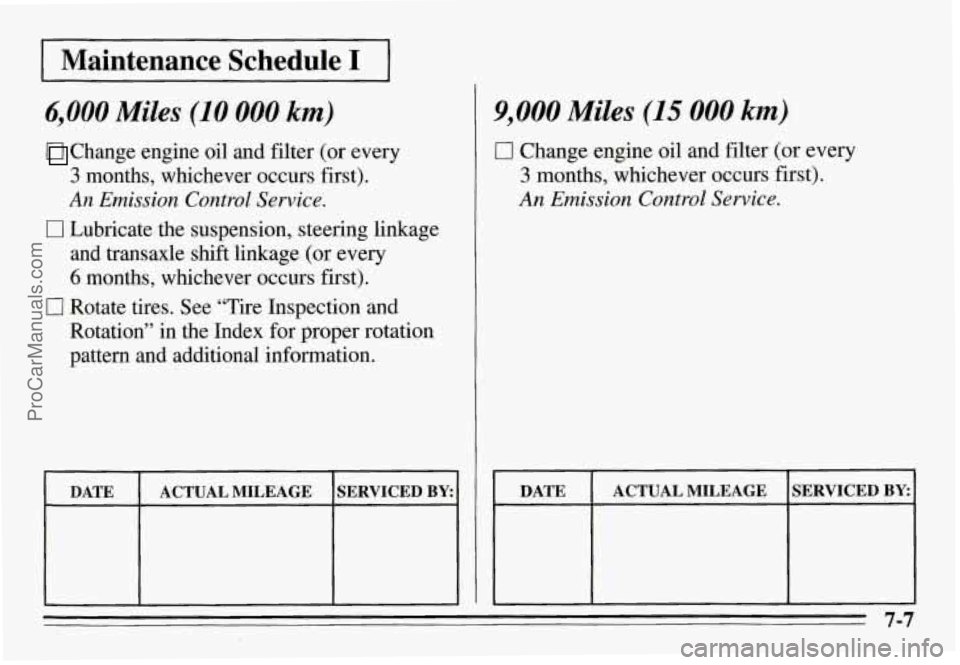
I Maintenance Schedule I I
6,000 Miles (10 000 km)
Change engine oil and filter (or every
3 months, whichever occurs first).
An Emission Control Service.
17 Lubricate the suspension, steering linkage
and transaxle shift linkage (or every
6 months, whichever occurs first).
0 Rotate tires. See “Tire Inspection and
Rotation” in the Index for proper rotation
pattern and additional information.
9,000 Miles (15 000 km)
0 Change engine oil and filter (or every
3 months, whichever occurs first).
An Emission Control Service.
DATE ACTUAL MILEAGE SERVICED BY:
7-7
ProCarManuals.com
Page 277 of 354
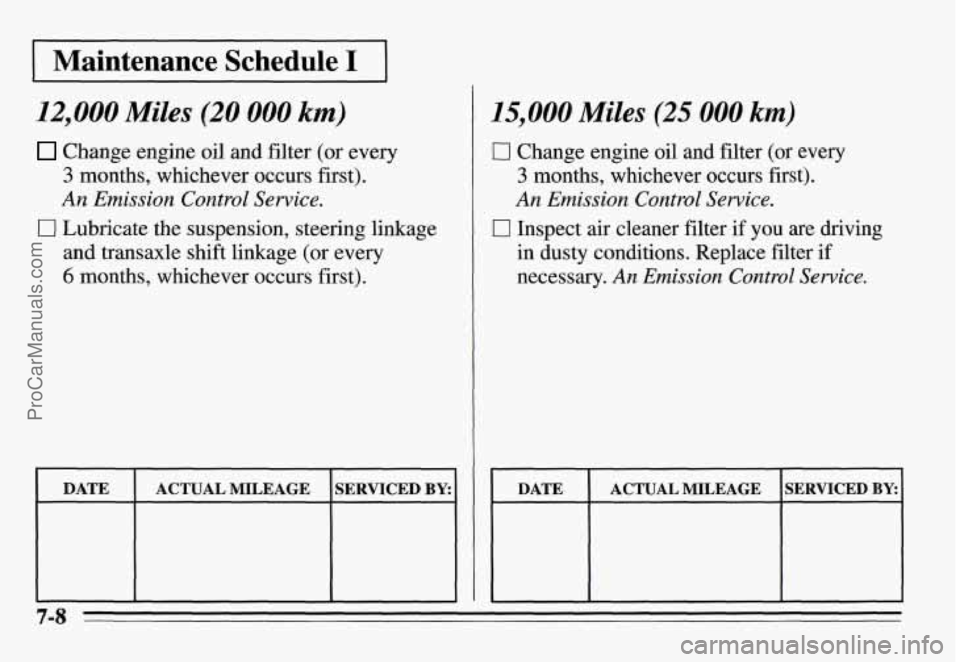
I Maintenance Schedule I I
12,000 Miles (20 000 km)
Change engine oil and filter (or every
3 months, whichever occurs first).
An Emission Control Service.
0 Lubricate the suspension, steering linkage
and transaxle shift linkage (or every
6 months, whichever occurs first).
DATE
SERVICED BY: ACTUAL MILEAGE
15,000 Miles (25 000 km)
0 Change engine oil and filter (or every
3 months, whichever occurs first).
An Emission Control Service.
17 Inspect air cleaner filter if you are driving
in dusty conditions. Replace filter
if
necessary. An Emission Control Service.
DATE SERVICED BY: ACTUAL MILEAGE
7-8
ProCarManuals.com